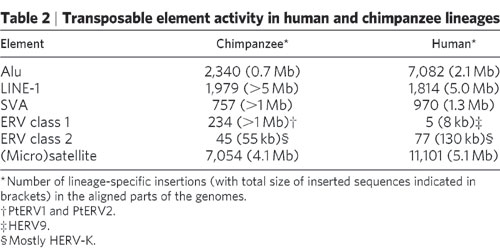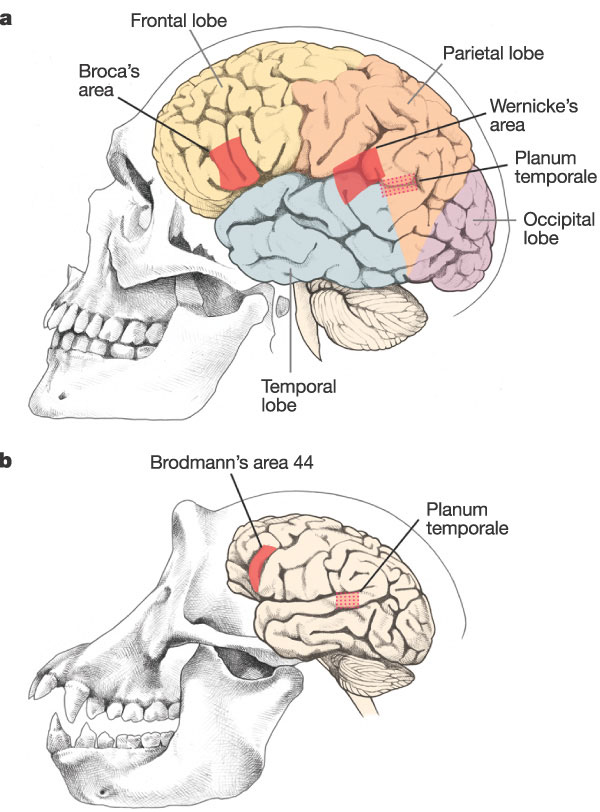Please explain why it isn't a phylogenetic argument.
Because it's an homology argument, things alike are proof of common ancestry.
Did you read the paper?
"Using the procedure described above, we identified a total of 425 full-length chimpanzee endogenous retroviruses."
They only looked at 425 out of the 200,000+ ERVs in the chimp genome. Of course, we have all shown you this multiple times, yet you continue to ignore these facts.
Did you read this one? With more than 100 members, CERV 1/PTERV1 is one of the most abundant families of endogenous retroviruses in the chimpanzee genome. (
Genome Biol. 2006). They can be found in African great apes but not in humans. What is more the ERV virus is nearly extinct in the human genome with only a couple that actually work.
Are they found at orthologous positions in the chimp and gorilla genomes? Nope. Once again, the distribution of ORTHOLOGOUS ERVs follows the predicted phylogeny, and that is what evidences common ancestry.
Exactly, all you want to talk about are the ones that are exactly or nearly exactly the same, aka orthologous. You don't want to talk about one of the most abundant families of endogenous retroviruses in the chimpanzee genome.
It is. Chimps share more DNA with humans than they do with gorillas or orangutans.
Which doesn't matter.
Genes only make up a tiny portion of the genome.
Which also doesn't matter.
Deleterious effects, starting with SRGAP2. What is the problem with 7 amino acid replacements in a highly conserved brain related gene? The only observed effects of changes in this gene in humans is disease and disorder:
- 15,767 individuals reported by Cooper et al. (2011)] for potential copy-number variation. We identified six large (>1 Mbp) copy-number variants (CNVs), including three deletions of the ancestral 1q32.1 region…
- A ten year old child with a history of seizures, attention deficit disorder, and learning disabilities. An MRI of this patient also indicates several brain malformations, including hypoplasia of the posterior body of the corpus callosum…
- Translocation breaking within intron 6 of SRGAP2A was reported in a five-year-old girl diagnosed with West syndrome and exhibiting epileptic seizures, intellectual disability, cortical atrophy, and a thin corpus callosum. (Human-specific evolution of novel SRGAP2 genes by incomplete segmental duplication Cell May 2012)
The search for variation with regard to this vital gene yielded no beneficial effect upon which selection could have acted. The only conceivable way the changes happen is relaxed functional constraint which, unless it emerged from the initial mutation perfectly functional it surly would have killed the host. Mutations are found in children with 'developmental delay and brain malformations, including West Syndrome, agenesis of the corpus callosum, and epileptic encephalopathies'.(cited above)
The explanation is mutagenesis. Look it up.
No need.
False.
Anyone can see that Australopithecines are not chimps. They have human-like pelvises and not chimp-like pelvises.
Anyone seriously thinking about this has the human brain to explain.
FIGURE 2. Comparative neuroanatomy of humans and chimpanzees. (Genetics and the making of Homo sapiens. Nature April 2003)
We are talking about the human brain. But, since you brought it up:
Concurrent with the prominence of the Piltdown fossil Raymond Dart had reported on the skull of an ape that had filled with lime creating an endocast or a model of what the brain would have looked like. Everyone considered it a chimpanzee child since it’s cranial capacity was just over 400cc but with the demise of Piltdown, a new icon was needed in the Darwinian theater of the mind. Raymond Dart suggests to Louis Leakey that a small brained human ancestor might have been responsible for some of the supposed tools the Leaky family was finding in Africa. The myth of the stone age ape man was born.
The Scottish anthropologist Sir Arthur Keith had built his long and distinguished career on the Piltdown fossil. When it was exposed it sent Darwinians scrambling, Arthur Keith had always rejected the Taung Child (Raymond Dart’s discovery) a chimpanzee child. Rightfully so since it’s small even for a modern chimpanzee. Keith would eventually apologized to Dart and Leakey would take his suggested name for the stone age ape man, Homo habilis, but there was a very real problem. The skull was too small to be considered a human ancestor, this impasse became known as the Cerebral Rubicon and Leakey’s solution was to simply ignore the cranial capacity.
"Sir Arthur Keith, one of the leading proponents of Piltdown Man, was particularly instrumental in shaping Louis's thinking. "Sir Arthur Keith was very much Louis's father in science" noted Frida. Brilliant, yet modest and unassuming, Keith was regarded at the time of Piltdown's discovery as England's most eminent anatomist and an authority on human ancestry...a one man court of appeal for physical anthropologists from around the world....and his opinion that assured Piltdown a place on every drawing of humankinds family tree." (Ancestral Passions, Virginia Morell)
Ever notice that there are no Chimpanzee ancestors in the fossil record? That’s because every time a gracial (smooth) skull, that is dug up in Asian or Africa they are automatically one of our ancestors.
Australopithecus afarensis: AL 288-1
Australopithecus africanus: Taung 1
Lucy a Chimpanzee
Taung Skull not Human-like 26 August 2014
These two are the only Hominid fossils I've seen that are really being passed of as transitional. They both have chimpanzee size brains, with all the features one would expect of a knuckle dragging, tree dwelling ape. What is far more important then finding something indicating a transitional fossil, which they have failed to do, is to understand what the basis of the three-fold of the human brain from that of apes:
Why can't 60 de novo genes related to highly conserved brain related functions be explained by random genetic mutations?
This all has to occur after the chimpanzee human split, while our ancestors were contemporaries in equatorial Africa, with none of the selective pressures effecting our ancestral cousins. This is in addition to no less then 60 de novo (brand new) brain related genes with no known molecular mechanism to produce them. Selection can explain the survival of the fittest but the arrival of the fittest requires a cause:
The de novo origin of a new protein-coding gene from non-coding DNA is considered to be a very rare occurrence in genomes. Here we identify 60 new protein-coding genes that originated de novo on the human lineage since divergence from the chimpanzee. The functionality of these genes is supported by both transcriptional and proteomic evidence. RNA– seq data indicate that these genes have their highest expression levels in the cerebral cortex and testes, which might suggest that these genes contribute to phenotypic traits that are unique to humans, such as improved cognitive ability. Our results are inconsistent with the traditional view that the de novo origin of new genes is very rare, thus there should be greater appreciation of the importance of the de novo origination of genes…(De Novo Origin of Human Protein-Coding Genes PLoS 2011)
Whatever you think happened one thing is for sure, random mutations are the worst explanation possible. They cannot produce de novo genes and invariably disrupt functional genes. You can forget about gradual accumulation of, 'slow and gradual accumulation of numerous, slight, yet profitable, variations' (
Darwin). That would require virtually no cost and extreme benefit with the molecular cause fabricated from vain imagination and suspended by pure faith.
Have a nice day

Mark




